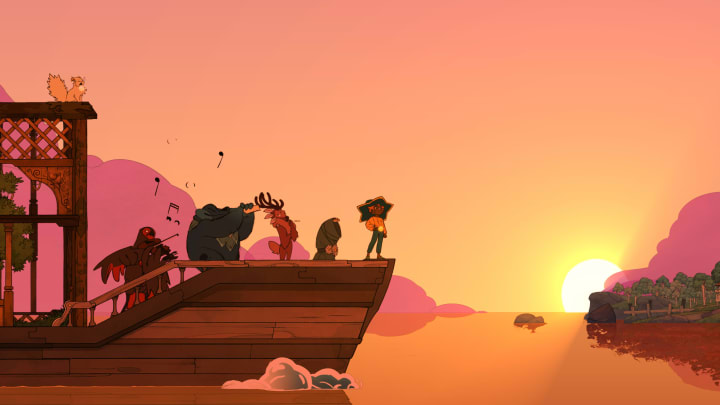Meet Your Adorable New Spirit Family in Spiritfarer

Death has never looked so cute as it does in Spiritfarer. The upcoming management adventure from Thunder Lotus Games wears its heart on its sleeve, and that sleeve is soft, colorful, and comforting as a favorite blanket.
Spiritfarer places players in the role of Stella, a young girl who has taken on the task of ferrying spirits from this life to the next. Although the game takes inspiration from the Greek myth of Charon, the ferryman of the River Styx, Stella has swapped out the lonely canoe for a great galleon. Several spirits live on the ship at any moment, and it's the player's job not just to take them to their rest, but to keep them content and comfortable along the way.
Thunder Lotus is known for Jotun and Sundered, two solemn, perhaps even dark, games about what it means to die. When the team was trying to figure out what to make next, they realized that death had become a throughline in their work, but that there was room for a fresh perspective on the ultimate end.
"Death doesn’t have to be scary," art director Jo-Annie Gauthier told me. "Death can be just another step."
Taking inspiration from Hayao Miyazaki's masterpiece "Spirited Away," the team started building out a world of warm invitation that didn't sugarcoat or shy away from its subject matter. Instead, as in the film, Spiritfarer uses its beautiful visuals to balance out the potential darkness of its subject. The colors are warm and bright, the world is aswirl with soft light, and characters move with a smooth fullness of motion that catches the eye and holds it.
But that bright aesthetic belies a nuanced exploration on the process of dying.
"Everybody’s lost someone, and everybody’s mortal," said Gauthier. "We’re all faced with that inevitability at some point.” But people don't vanish completely when they die. Instead, all that they've taught or shared with others lives on in those people.
"We wanted to make sure that we didn’t portray the death of someone as the end of that person as an idea, and as an entity in the other people’s lives."
Gauthier said all the spirits in the game were based on real people who members of Thunder Lotus had lost, already a form of memorializing and making permanent those who pass on. Ideally, the emotions of those real-life losses translate to the game in a way players can feel.
And that notion of a life beyond death — not in an afterlife, but in the lives of others — also sees powerful reinforcement in the game's mechanics. At the start of the game, Stella has few skills or abilities, and her ship is empty of attractions. Whenever a spirit joins her on the ship, she has to rearrange the structures already there to accommodate the new companion's need for living space, food, and affection. Stella can offer to hug any of the spirits in the game — though they won't all say yes.
"Some people on the boat will be people-pleasers, will be people-people," Gauthier said. "Just love talking, love chatting. And some spirits will be completely hermits, and not talking to them will actually improve their mood."
The spirits have the ability to turn down hugs, as Thunder Lotus felt it vital to engage with consent when it came to physical touch.
Stella also has to balance these new homes with gardens, kitchens, forges, and more, each with their own set of required resources, tools, and skills. Over time, the spirits Stella houses will teach her those skills, from smelting to weaving and more. In the demo I played, Stella learned to double jump by sending one spirit to the afterlife. The spirits also teach her lessons about how to live, how to connect with others, and countless other vital, emotional tidbits.
When spirits do eventually move on, their rooms stay on the ship. This ensures players won't forget about the time they spent together, and about what they learned from that spirit. It also presents a challenge, as new spirits' homes will need to be planned for and fit into the space.
Thunder Lotus paid special attention to how its management simulator would handle a subject as serious as death. Insufficiently deep mechanics would make for a boring game, but too much gamification could threaten to undermine the fundamental seriousness of the story.
"You don't want this to feel like a collectathon of dead people," Gauthier said.
Although time with the demo was limited, Gauthier told me about one of 12 spirits the team is aiming to include in the full game. An elderly hedgehog, she's based on a team member's grandmother.
"She’s old and frail, and at some point in the game when she’s getting closer to being ready [to pass into the spirit world], she’s too weak to walk."
Rather than force her to climb the ladders and stairs on the ship to get down, players must rearrange their structures and lower her house to the ground. Even hearing the moment described was emotional, and I told Gauthier I could already see this game making me cry.
She laughed, then leaned in to whisper conspiratorially. "I hope so!"